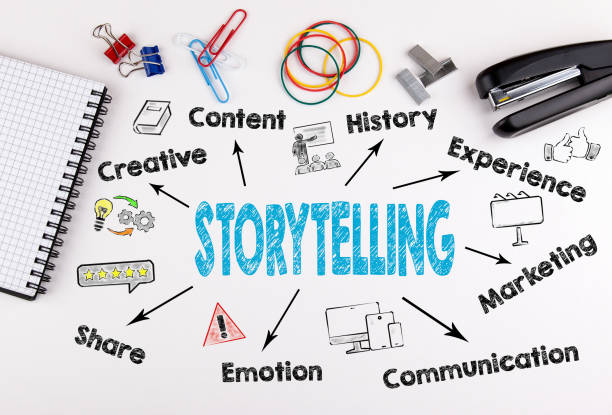Est. reading time: 6 minutes

Have you ever wondered how the world would be if there were no stories to tell? Blank, probably. We have been programmed to want to listen to, watch, or read stories, and our brains have transformed to love them. And that is who we are: storytellers. We make stories, and stories make us. In this article, we will discuss attention-grabbing storytelling ideas you can incorporate to communicate your brand effectively to your audience. We will walk you through brand storytelling, its importance, and the types of storytelling ideas to use for your brand. Let’s get right into it.
What is a Brand?
You will agree that in recent times, the term “brand” has become like MTN, which you hear almost everywhere you go. Nearly everyone is talking about having a brand. Don’t get it wrong. We are not saying it’s not a good idea; we want you to gain more insights into what a brand is.
When you hear the term “brand,” what comes to mind is a logo or name; well, you might be right. However, a brand is all of these and many more. A brand is beyond what you see; it’s a perception of what people feel about a business or an individual.
A brand is simply a flag for a product-producing or service-rendering organization. Imagine you have a clothing shop where you make fashionable agbada. Beyond the name, logo, or even marketing, how does the agbada make your customers feel? Is it safe, comfortable, or uneasy? How people feel about what you do—that’s it—that’s branding.
What is Brand Storytelling?
Brand storytelling is the process of narrating a series of events about a brand to the target audience to create an emotional connection between the two parties. If a brand is about how people feel about a product or service, then brand storytelling is telling people how to feel about your brand. It’s more of a marketing approach that involves connecting with your brand’s target audience on an emotional level.
You probably have heard that you cannot control how people feel about you; that’s not entirely true. Although you cannot control how people feel, you can control what you do to influence their perception of your product or service.
Let’s look at it from this angle as well. Imagine a brand as a person. As a person, you have a story; likewise, a brand has its story, too. Brand storytelling is a channel for communicating to the targeted audience what the brand is and what it represents, including its values, mission, and vision.
Creating a story for a brand extends beyond the functional purpose the brand serves. You want to narrate a story that the target audience will be able to connect to. So, brand storytelling is not just about telling a story; it is also about how you tell the story.
Why Brands Should Consider Storytelling?
The aim of telling a story differs for different people. Here are the reasons brands should use storytelling as a hack in relating with the audience:
1. Attention
Research has revealed that the average human attention span is now less than 9 minutes. Quite low, isn’t it? In a world where attention spans are rapidly diminishing, storytelling is the fastest tool for grabbing attention and keeping the audience glued to whatever message you want to pass across.
2. Lasting memory
Here’s a simple question for you. Can you remember the year you watched or heard the story of Cinderella? Can you still remember the story? That is the power of storytelling. It is easier to remember stuff when it is in story form. Jerome Bruner, an American cognitive psychologist, stated from his research that people are 22 times more likely to remember a fact when it has been coated in a story.
3. Distinction
You are aware you are not the only one in the business you are doing or you want to do. There is no new thing anywhere. So, there are other people as well, and these are your competitors. But with great storytelling skills up your sleeve, you can set your brand apart and stand out from the crowd. Seth Godin, a marketing expert, said, “Marketing is no longer about the stuff that you make, but about the stories you tell.”
4. Trust and Relationship building
In brand storytelling, you are not telling a story only to grab attention; you are also telling that story to increase engagement, drive sales, and build a relationship. Let’s take Coca-Cola, for instance.
Coca-Cola is a brand known for producing a wide range of soft drinks and other beverages. This company has been in existence for hundreds of years, but Coca-Cola is still most people’s favourite. Multiples of other brands have been created to produce the same product; however, Coca-Cola has retained its glory to this present day.
So what could be their secret?
Coca-Cola has built a strong relationship with its customers by narrating different stories that not only grab their attention but also inspire and resonate with them. Humans are emotional beings, and stories go straight into our hearts.
Storytelling Ideas That Can be Used by Brands
Building a brand is great, but investing in good storytelling will do your brand a lot of good. Here are the six storytelling ideas brands can use to tell their stories better:
1. Origin story
Remember we said that a brand is like a person? Just like every person has a birthday, a brand has a day it was birthed, too. Every birth has its fun moments, hurdles, and triumphs. One idea for telling a brand story is using the origin story to pass across a transforming and motivating message to the audience. Consider looking into the models of Mercedes Benz that were produced a long time ago and the models being produced now. It is like a before-and-after story that can be used by brands to connect with their audience.
If a brand is considering using this idea, these questions will serve as a guide:
(a) Who is the founder?
(b) What inspired the founder?
(c) What were the challenges encountered?
(d) How are the challenges resolved?
2. Purpose and Mission
“Why does the brand exist? What is the motto? What problem does the brand intend to solve? How will the brand contribute to society? What is the founding problem that made the brand come into existence?.” All of these questions drive a brand’s purpose. Make the target audience feel that the brand is not just selling a product or rendering a service. Show that the brand cares.
Nike released an ad some time ago. It is a one-minute, 10-second video that generated over a million views on YouTube. The video does not show footwear, and there is nothing about athletics. At all. It was just a room filled with babies on their beds; some lay on their backs crying, and some sat on the bed. This video showcased Nike’s motto: Just do it. Remember what we said: a brand is more of people’s perception of a business. Nike produces footwear, but beyond the product, the brand’s purpose and mission are to pass a message that greatness can be achieved if you are willing to take that step.
3. The Hero’s journey
What is a story without a conflict? It is no brain teaser that life is not a bed of roses. Hence, a brand storytelling idea is to narrate a relatable event the audience can connect to, not an all-around rosy story. The hero, who represents a would-be consumer, sets out on a journey, encounters challenges, and the brand steps into the equation to provide a solution.
One important factor to consider is that the hero is the would-be customer, not the brand. The brand acts as a supporting actor by solving the problem and improving the customers’ lives. The story should be about the audience. Make the audience the centre of attraction.
4. Unique Selling Point [USP]
This is what makes a brand different from its competitors. The distinction could be in the materials or the processes involved. Make a list of these differences and create a story with it.
5. Users Generated Content [UGC]
User-generated content is one of the amazing content ideas for brand visibility. Here, the existing customers create content about them using the brand’s product or service and how it has improved their lives. This idea is quite effective as it builds trust and assures capability and credibility. Popular brands like Coca-Cola and Nike have used this idea. Coca-Cola conducted a “Share a Coke” campaign by encouraging customers to share pictures of themselves with Coke bottles. At the same time, Nike had their customers participate in the “Find Your Greatness” campaign.
6. Reviews and Testimonials
It is similar to UGC. In UGC, the customers create the content and post it, while for testimonials, the content can be created either by the customer or the brand, and the brand publicizes it.
Conclusion
In this article, we have demystified a brand, why storytelling is important, and the storytelling ideas suitable for brands. Storytelling matters to a brand as it helps to grab attention, make it stand out, and imprint a lasting memory. However, while it is important to use storytelling, always remember that brand storytelling is not fiction; therefore, authenticity matters. Tell stories, but tell stories that are real. Do you want to incorporate storytelling into your brand? You definitely need an expert to handle it for you, and we at Kian Consult are ready to help.

